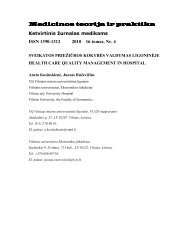UPGRADING AND RE-USING TECHNOLOGIES FOR FOOD WASTE
UPGRADING AND RE-USING TECHNOLOGIES FOR FOOD WASTE
UPGRADING AND RE-USING TECHNOLOGIES FOR FOOD WASTE
- No tags were found...
Create successful ePaper yourself
Turn your PDF publications into a flip-book with our unique Google optimized e-Paper software.
<strong>FOR</strong>UM WA<strong>RE</strong> INTERNATIONAL 1 (2008) 25EstoniaFinlandLithuaniaDenmarkBulgariaRomaniaPolandCzech RepublicUnited KingdomBelgiumPortugalGreeceFranceSpainItaly1222233344788167010 100 200 300 400 500 600 700 800Quantity of certificatesFig. 1: EU top 15 countries by the quantity of SA 8000 certified enterprises (September, 2007)Source: Calculated by the authors.LatviaHungaryEstoniaFinlandBulgariaPolandSloveniaGreeceRomaniaBelgiumCzech RepublicLithuaniaSpainPortugalItaly0,030,030,040,060,060,080,080,130,170,170,240,320,630,672,090,00 0,50 1,00 1,50 2,00 2,50Quantity of employees at certified enterprises per 1000 populationFig. 2: EU top 15 countries by the quantity of employees at SA 8000 certified enterprises per 1000 of thepopulation by country (September, 2007)Source: Calculated by the authors.By the official statistics indicator – number of certified organizations, Lithuania is clearly behindEuropean and worldwide leaders. But by the quantity of SA 8000 certified enterprises per 1000 of thepopulation by country Lithuania is the 2 nd in the world. Lithuania is the 4 rd between EU countries accordingto the number of employees at SA 8000 certified enterprises per 1000 of the population by country (fig.2).Italy is absolute leader in EU and in the World by the all three mentioned CSR activities indicators.According to authors, the quantity of employees at SA 8000 certified enterprises per 1000 of the population
<strong>FOR</strong>UM WA<strong>RE</strong> INTERNATIONAL 1 (2008) 26by country is the most objective indicator for countries social responsible business level assessment.Therefore, this relative indicator can be recommended for international benchmarking of social responsibleactivities in different countries and regions.Links between corporate social responsibility and human resource managementMore and more organizations tend to agree that the success of sustainable and socially responsiblebusiness, also fulfilment of stakeholders needs cannot be reached while orienting to short time profitobjectives. Requirements of society and sustainable development have to be considered. Any kind oforganization firstly has to be considered as the unit of society, which makes impact on all its components. Acompany is dependant on a wide range of stakeholders, who are personally interested in the activities of anorganization and may also impact on forming and managing it. While making decisions organization has tocoordinate different interests of its stakeholders. Identification, classification and needs analysis of thestakeholders are effective means, which help to analyze different aspects of organization’s activities alsoeconomic, social and political aspects of the country (Akgeyik, 2005; Wilcox, 2006). The concept ofcorporate social responsibility firstly means taking care of the impact organization makes to society andstakeholders. Such activities spheres of social responsibility might be stressed out (Sieber, 2005; Koziol andKoziolowa, 2005; Gudoniene and Leipuviene, 2007; Ruzevicius and Navickaite, 2007):stimulation of transparent and ethical business;assurance of employees’ health and safety at work;improvement of psychological climate at work;development of equal rights;responsibility against consumers and customers;decreasing negative impact in environment and introduction of environment management means;development of ecological products and services;personnel trainings;organizing employees (their families) leisure time, propagating healthy life style;participating in society life;development of region economics .Many CSR activities are oriented to employees, it follows that a socially responsible company shouldfirstly take care of its employees by increasing the investments to intellectual capital and health and safety atwork. On the other hand, organizations are dependant on local communities – they use local labour market,that is why they are and should be interested in health, education and other needs of the local inhabitants. Itmakes clear the fact, that HRM policy and practices are one of the main parts of CSR. Besides,interrelationships of business and employees of business companies is an important assumption of CSR: if acompany does not take responsibility for its employees, it is probably the same irresponsible with theconsumers of its products or the social and natural environment, in which it proceeds.Human resource management is an idiosyncratic attitude to personnel management, which seeks forcompetitive advantage through strategic actions – using cultural, structural and personnel managementtechniques while creating competent and responsible workforce. Modern organization takes its employees asvaluable asset, which has to be systematically developed, but not as the costs, which have to be managed(Armstrong, 2006; Beardwell and Claydon, 2007). Employees are the most important stakeholders, who areinterested in the successful performance of the company. The objective of HRM is to use means andmethods, which would stimulate the development of flexible and engaged employees (Zappalà, 2004;Wilcox, 2006). HRM encompass such activities as formation of organizational psychology, personneladministration, human resource planning, recruitment, organizational development, formation ofmotivational and bonus system, organization of trainings, career planning, solving internal personnelproblems and etc. (Beardwell and Clydon, 2007). Links between CSR and HRM might be seen in figure 3,where you can see objects and factors of HRM. Social and economic environment forms the demands ofstakeholders which finally have impact on personnel management and long term results make impact onprimary factors.More instruments linking CSR and HRM are the international voluntary social responsibility standards –SA 8000 and OHSAS 18001. On the grounds of SA 8000 (Social Accountability) standards, there are
<strong>FOR</strong>UM WA<strong>RE</strong> INTERNATIONAL 1 (2008) 27systems ensuring environmental and main human rights in all work places created. OHSAS 18001 concernsOccupational Health and Safety Management Systems. Extensive attention to human rights and sociallyresponsible activities of organizations is paid by Global Compact initiative, also Codes of conduct issued indifferent companies, which are widely used in HRM and are introduced when institutionalizing modernethics to all practical spheres of business (Ruzevicius and Navickaite, 2007; Gonzales, 2008).Stakeholders:ShareholdersManagementEmployees groupsGovernmentSocietyTrade unionsEnvironment:Characteristics oflabour forceBusiness strategyManagementphilosophyLabour marketTrade unionsTechnologyLaws and universalvaluesHRM policy:Influence ofemployeesChanges of HRSalary systemsWorking systemsHRM results:EngagementCompetenceConformityCost efficiencyLong-termresults:IndividualwelfareOrganizationalefficiencySociety welfareFig.3:HRM modelSource: Beardwell and Claydon, 2007.Analysis of CSR means brought generalization of direct and indirect interconnections between CSRand personnel management. As it might be seen from the table 1, analysis of needs and meeting those needsof internal stakeholders, i.e. employees of organization, is of great importance in most social responsibilitystandards and initiatives (in the table it is highlighted in red colour). Voluntary standards linking CSR andHRM directly are SA 8000 and OHSAS 18001. Other means in the table also point out the interconnectionbetween the analyzed concepts. It is obvious that HR development is inseparable from socially responsibleactivities.
<strong>FOR</strong>UM WA<strong>RE</strong> INTERNATIONAL 1 (2008) 28CSRinstrumentsCSRspheresConsumerrightsHuman rightsRelationshipswithemployeesEnvironmentalmanagementSRinvestmentsTransparencySA 8000 OHSAS 18001 ISO 9001 ISO 14001EMAS Global Compact GRI AA1000 EFQMmodelExcellence Tab. 1: Comparison of CSR meansSource: designed by authorsInternational CSR and HRM Research AnalysisVarious researches about CSR and HRM show that these means do indirect positive influence to theorganization’s financial results. CSR influences the employees’ morale, motivation, liability, loyalty,learning, recruitment and alternation. We can imply that HRM benefit to the companies is one of the mostimportant components of successful socially responsible activities. A survey, where 25000 respondents from25 countries participated, shows, that 80 percent of employees are better motivated and more loyal to theirorganization, when the company’s activities are comprehensively socially responsible (Environics..., 2002).A later survey in Europe also confirmed the positive influence of CSR – most of the employees fromanalyzed organizations (almost 90%) showed higher loyalty to employers, whose organizations are sociallyresponsible (Zappalà, 2004). A survey in USA showed that socially responsible activities have significantinfluence to employees’ satisfaction and loyalty. Employees who are participating in employer’s supportedsocially responsible events were 30 percent more interested to continue their work in their workplace andaim to associate for its prosperity (Cook, 2004).The question is – why employees are more motivated and engaged for the company if the employer issocially responsible and employees have the opportunity to take part in social activities? The main reason isprobably because money, especially in developed countries, is not the only factor making impact onemployees’ opinion, performance and motivation. One of the most important driving motives for CSR lays inthe aspiration to provide employees with the feeling of meaningfulness and the possibility to takeresponsibility for the quality of future generations’ life (Zappalà, 2004; Melinyte and Ruzevicius, 2007). Thisimplication emphasizes the importance of correctly addressed HRM in nowadays organization.Business organizations are functioning in competitive labour market and they constantly face the problemof attracting and maintaining high competence employees. For this reason it is important to identify and tounderstand the factors motivating people to choose one or another company. Employers must perceive thefactors, which create an image of attractive company. The image is of significant importance in stimulatingvaluable employees to become and to remain the part of a particular company. The research made in fewcountries showed that almost half (47%) of people searching for a job want to start working or to keep onworking in the company, which pays much attention to socially responsible activities in both – internal andexternal areas of the company (Palimeris, 2006).
<strong>FOR</strong>UM WA<strong>RE</strong> INTERNATIONAL 1 (2008) 29One more factor which needs to be emphasized when analyzing links between CSR and HRM isemployees recommendations to surroundings and future employees regarding the company they work in.Three quarters of United Kingdom employees, perceiving their company as socially responsible, wouldrecommend it to other potential employees, when only 43 percent of employees from not socially responsiblecompanies would give the same recommendation (Palimeris, 2006). The importance of this factor isreinforced by the results of the same survey, which says that 74 percent of respondents trust the opinionabout company’s socially responsible activities of an employee who is still working or was working in it,than the flyer or advertisement concerning this issue. One of the members of Global Compact in Lithuania –AB „Danisco sugar Kedainiai“ – in their report of communication of progress notes, that 93 percent ofemployees of the company in year 2005 would certainly or most probably recommend their company as agreat place to work in (AB Danisco..., 2005).Socially responsible activities are also used as a strategic instrument stimulating cooperation and teamwork. This is proved by a survey of the 50 biggest Turkish companies: 85 percent of them stressed theimportance of CSR activities and noted that they see them as a source of inspiration for team work.Respondents stated that employees having the same interests to gather to potential teams through sociallyresponsible programs, thus definitely improving the interrelations between employees (Akgeyik, 2005).Hence SR activities are the instrument for creating a meaningful and creative working environment. Theauthors have carried out a study about the nowadays Lithuanian employees’ perception of CSR and motivesto contribute, with a purpose to find out the tendencies and the potential for the development of CSR. 127managers and leaders from different companies (including companies from Global Compact and companieshaving ISO 14000 or ISO 9000 certificates) have presented the answers to the prepared questionnaire. Theperformed research revealed that employees of analyzed companies are informed about the sociallyresponsible activities quite well and that they appreciate the companies implementing CSR, they are alsowilling to contribute to social activities, hence the potential for development of SR is really great. The resultsof this study are announced in the authors’ article (Melinyte and Ruzevicius, 2008), and were used whencreating the framework of links between CSR and HRM.Framework of Links between CSR and HRMOn purpose to integrate corporate social responsibility and human resource management it was decidedto develop a framework representing the links between the two concepts, which would be theoretical andpractical. The framework aims to identify the links between CSR and HRM and to use it for seeking strategicobjectives of organization.Following the analysis of literature and results of different researches there were functions and results ofHRM distinguished which directly or indirectly relate to CSR activities. Because there are diverse linksbetween functions of CSR and HRM, there were three groups of linking functions formed:1. CSR functions identical to HRM functions (interdependent link – an equal sign between CSR and HRMis used). Functions presented in this group are validated in most countries by laws (in Lithuania it is thecode of labor, which is supervised by governmental inspection of labour), hence they coincide withobligatory requirements of an organization, though an honest implementation of them is attributed to SRactivities;2. HRM functions making impact on CSR (one-way link – SR activities emerging from HRM);3. CSR functions making direct or indirect impact on HRM (one-way link – how SR activities make impacton HRM).Analysis of CSR instruments revealed that most of SR standards and initiatives emphasize the importanceof meeting the needs of employees. Next to each group of links between CSR and HRM in the frameworkthere are particular CSR instruments rendered. Analysis and application of universally accepted instrumentsis directly addressed to improvement of organization’s performance results. The project of frameworkfollows to the premise, that organizations are acquainted with the conceptions of CSR and HRM. For thisreason, a deep analysis of the two concepts and the CSR instruments is needed before the framework can beapplied practically, if the concept wasn’t known. The first part of framework of links between CSR andHRM is presented in figure 4.
<strong>FOR</strong>UM WA<strong>RE</strong> INTERNATIONAL 1 (2008) 30I. CSR = HRMA. Elimination of child andforced labourB. Assurance of health andsafety at workC. Freedom of labourassociationsD. Assurance of equal rightsE. Working hoursF. Compensation for workG. Social guarantiesII. CSR HRMA. HR strategyB. Recruitment/ dismissalsystemC. Organizational cultureD. Management oforganizational changesE. Employees’ trainings andeducationF. Analyzing and meetingemployees needsG. Psychological climate atworkIII. CSR HRMA. CSR strategyB. RecruitmentC. Employees’ trainings andeducation (in CSR sphere)D. Analyzing and meetingemployees needsE. Employees involvementinto SR programsInstrumentsSA 8000, OHSAS 18001, ISO9004, Global Compact, GRIInstrumentsCode of ethical conduct, ISO 9004,EFQM Excellence modelInstrumentsISO 26000, ISO 14000,EMAS, eco-labelling, GlobalCompact, AA 1000Internal advantagesObligatory requirements are metAttraction of new employeesMotivationSatisfactionLoyaltyPartnership atmosphereExternal advantagesImage, prestige, statusSatisfaction and trust ofcustomersMarket shareProfitAttraction of investmentsSpecificadvantagesEasierintegration toEUPotential fordecreasedemigrationFig.4:Scheme of frameworks of links between CSR and HRMSource: designed by authorsOne of the most important criterions when starting any kind of activity is the possibility to reach settledobjectives. Among final results in the framework are those advantages, which are divided to three parts:internal, external and specific advantages. The first two are common to all organizations, while the third oneis a specific advantage for organizations in post-soviet countries.The second part of framework is presented by an expanded list of CSR and HRM functions. This is anexplanatory part of the framework which aims to present how the functions stated in framework have to beimplemented and also specifies which CSR instrument corresponds to a particular function. The expandedlist of functions was formulated with reference to scientific literature.Both parts of the framework are inseparable, i.e. the first part cannot exist without the explanatory part,because it describes shortly the functions linking CSR and HRM. They even tend to repeat in differentgroups of function, but only the general name of function repeats, while its content when looking from otherperspective (i.e. from CSR or HRM) is totally different. The exact meaning of the particular function isdefined explicitly in the explanatory part.Hence in the first part of framework it is stated what function has to be implemented and the second partexplains how it has to be implemented in order to reach the linkage to CSR or for SR activity to makepositive impact on HRM, because functions in the framework might be implemented in a variety of differentways.
<strong>FOR</strong>UM WA<strong>RE</strong> INTERNATIONAL 1 (2008) 31Hereinafter is presented the explanatory part of the framework (tables 2, 3 and 4).Functions Explanation CSR instrumentsA. Elimination ofchild and forcedlabourB. Assurance of healthand safety at workC. Freedom of labourassociationsD. Assurance of equalrightsNot tolerating any kind of non acceptable behaviour withemployees, such as any kind of forced labour, child labour.Managing risk factors of professional health and safety(obligatory health checkups etc.), health friendlyenvironment at work.Opportunity to form professional labour associations andacceptance of rights for collective bargaining.Stimulation of equal rights of employees in all levels of acompany, with respect for colour, race, gender, age, ethicaland religious beliefs, disabled employees. Policy andprocedures for assurance of such rights.E. Working hours Guaranty of permissible working hours, time for lunch,record of overtime, work at nights, trainings on workinghours or after working hours, time spent on business trips,vacations and holidays time.SA 8000,GC 1 4’th and 5’thprinciples, GRISA 8000, OHSAS18001, ISO 9004,GRISA 8000, GC 3’rdprinciple, GRISA 8000, GC 6’thprinciple, GRISA 8000F. Compensation for Assurance of fair compensation for work for all employees. SA 8000workG. Social guaranties Payment of taxes for government, assurance of rights to getwelfare benefits.SA 8000, GC 10’thprincipleTab. 2: CSR activities identical to HRMSource: designed by authorsFunctions Explanation CSR instrumentsA. HR strategy Setting long-term objectives for HR, including SR objectivesto it. Foreseeing: where we go and where we want to get.B. Recruitment/dismissal systemC. OrganizationalcultureD. Management oforganizationalchangesE. Employees’trainings andeducationHR managers initiate social aid programs and form the codeof ethical conduct, the scheme of internal benefit system.Objective and honest recruitment, search and selection ofemployees and dismissal policy, guaranteeing transparencyof the company.Culture of openness, assurance of communication (share ofknowledge); delegating programs, which proves respect,trust between managers and employees; transparent workingconditions.HR manager is responsible for initiating organizationalchanges concerning SR issues and guaranteeing rights ofemployees.Providing trainings for all levels of employees, forming andcouching new competencies and professionalism, providingCode of ethicalconductCode of ethicalconductCode of ethicalconduct, EFQMExcellence modelCode of ethicalconductISO 90041 GC – abbreviation for Global Compact
<strong>FOR</strong>UM WA<strong>RE</strong> INTERNATIONAL 1 (2008) 32F. Analyzing andmeetingemployees needsG. Psychologicalclimate at workemployees with continued learning.Policy for studying vacations, offering the payment foremployee’s studies at university or other institution.Trainings concerning CSR issues.Balance between work, family and other personal aims (eg.flexible timetable for parents), free insurance and medicalcare for employees, conditions for productive work atworkplace, career planning, and constant review of trainingsplan.Safety, objectivity, spiritual comfort, acknowledgement,respect, honest psychological atmosphere; proper ethics ofworkplace; fair system incentives and evaluation ofemployees.Code of ethicalconduct, ISO 9004,EFQM ExcellencemodelCode of ethicalconduct, ISO 9004Tab.3: HRM functions making impact on CSRSource: designed by authorsFunctions Explanation CSR instrumentsA. CSR strategy Setting long-term objectives for CSR and including it toorganization’s strategy. Include employees, as one of themain stakeholders to CSR strategy and set the means forreaching the objectives set.B. Recruitment Socially responsible organizations possess the potential toattract competent specialists. Seeking for this objective theorganization should declare its SR activities in the means ofsearch of employees.C. Employees’trainings andeducation (in CSRsphere)Trainings and programs concerning SR issues, which allowintroducing the employees to universal ethics and values,transparent work conditions.ISO 26000,14000, EMAS,Eco-labelling,Global Compact,AA 1000,Code of ethicalconduct-D. Analyzing andmeetingemployees` needsE. Employees’involvement intoSR programsAnalyzing and meeting employees` needs in the SR sphere.Including employees to the process of the code of ethicalconduct creation with a purpose to make the employeesdecide upon the atmosphere in the workplace they want tocreate and have.Organizing public CSR programs including the employeesof organization, also organizing internal SR programs (e.g.sorting waste at workplace). Incentive system foremployees` initiatives in SR sphere.Code of ethicalconduct-Tab. 4: CSR functions making impact on HRMSource: designed by authorsBecause wrongly set attitude is still prevailing, stating that CSR is artificially imposed to businessorganizations, there is a need for organizations to realize that socially responsible activities arise from theorganization itself naturally. The created framework is being offered as an instrument which would help tochange the prevailing attitude. Besides, most of the functions stated in the framework in a lot oforganizations are already being implemented, the problem lays in the lack of information companies have
<strong>FOR</strong>UM WA<strong>RE</strong> INTERNATIONAL 1 (2008) 33about the CSR. As a result of that organizations do not use the advantages CSR provides (e.g. for attractingemployees).The framework of links between CSR and HRM is designed for organizations operating in differentspheres, though considering their nature particular functions might be implemented more efficient, that iswhy the model can be adapted to certain organization and the adjustment is allowed.ConclusionsCorporate social responsibility means moral obligations and activities of a company, when not onlyjuridical, but also universally accepted moral, justice, environmental and humanity norms are followed. SRactivities provide business with new possibilities, through which the image and reputation of the companytrust of society, position in the market, motivation of employees, the ability to attract employees and theculture of the company improve.The comparative estimation of different countries corporate responsibility by absolute variable of certifiedsystem and tools quantity is not informative enough. According to authors’ opinion, the quantity ofemployees at SA 8000 certified enterprises per 1000 of the population by country is the most objectiveindicator for countries’ social responsible business level assessment. Therefore, this relative indicator can berecommended for international benchmarking of social responsible activities in different countries andregions.The framework of links between CSR and HRM provided by the authors concentrates on humanresources, because training, motivating and meeting the needs of employees is especially important for thesuccessful existence of the organization. The framework enables:– to evaluate socially responsible activities of the organization, which are interconnected with humanresources;– to select CSR instruments for improving particular activities;– to identify advantages emerging from the links between CSR and HRM and to use them purposefully;– to use it for developing CSR ideas and educational purposes in business, studies and other communities inthe public sector.The framework of links between corporate social responsibility and human resource managementpropose main activities for relating two conceptions that should be implemented in the way of seekingorganizational activities effectiveness. The framework can be used not only for development of organizationsbut also for stimulating spread of CSR conception in business, public sector and society. The framework hasto be adapted considering different cases, i.e. particularity of organization activities, integrated managementsystem and organizational culture.<strong>RE</strong>FE<strong>RE</strong>NCES:1. AB „Danisco sugar Kėdainiai“. Sustainability Report 2005. Internet: http://www.danisco.com/sustainability (15.02. 2008).2. Akgeyik, T. (2005): The human resource management dimensions of corporate social responsibility in Turkey: a survey (1). In.:Journal of Academy of Business and Economics, January 1, pp. 25-32.3. Armstrong, M. (2006): Strategic human resource management: a guide to action. Third edition. London: Kogan Page.4. Beardwell, J., Claydon, T. (2007): Human resource management: a contemporary approach. Fifth edition. Harlow, England: FTPrentice Hall.5. Collierand, J., Esteban, R. (2007: Corporate social responsibility and employee commitment. In.: Business Ethics: A EuropeanReview, 16, pp. 19-33.6. Cook, T. (2004): Communicating with Employees. A Jackson Wells Morris White Paper. Internet: www. trevorcook.typead.com(17.01.2008).7. Enquist, B., Edvardsson, B., Sebathu, S. P. (2007): Corporate Social Responsibility for Charity or for Service Business? In.:10th QMOD Conference Proceedings, Helsingborg, pp. 1-11.8. Environics International (2002). Corporate social responsibility monitor. Environics International. Internet:http://www.globescan.com/news_archives/csr_exec_brief.pdf (17.01.2008).
<strong>FOR</strong>UM WA<strong>RE</strong> INTERNATIONAL 1 (2008) 349. Gonzales, R. (2008): Understanding Social Responsibility in UAE: Taking the Lead to become a Regional Leader in CSR. In.:Creating an Architecture of Quality and Excellence in the Middle East: Responsibilities, Challenges and Strategies: Proceedingsof MEQA Congress, Dubai, pp. 349-356.10. Gudoniene, V., Leipuviene, K. (2007): Analysis of social initiatives in business: benefits, costs, impact for business and society.Vilnius: Report by UAB „Ekonominės konsultacijos ir tyrimai“.11. Koziol, J., Koziolowa, A. (2005): Commodity science and corporate social responsibility. In.: Current Trends in CommodityScience. Proceedings of the 8th International Commodity Science Conference, Poznan, vol.1, pp. 116-122.12. Ledwidge, J. (2007): Corporate social responsibility: the risks and opportunities for HR. In.: Human resource managementinternational digest, 15 (6), pp. 27-30.13. Melynyte, O., Ruzevicius, J. (2008): The study of interconnections of corporate social responsibility and human resourcemanagement. In.: Economics and management, 13, pp. 817-823.14. Palimeris, M. (2006): Engaging Employees through Corporate Responsibility. United Kingdom: Ipsos MORI White Paper.15. Ruzevicius, J., Navickaite, V. (2007): The development of socially responsible business in Lithuania and Italy: a comparativestudy. In.: Economics and Management, 12, pp. 1025-1032.16. Ruzevicius, J., Serafinas, D. (2006): Socially responsible business. In.: Commodities and Markets, 2, pp. 27-36.17. Simmons, J. (2003): Balancing performance, accountability and equity in stakeholder relationships: towards more sociallyresponsible HR practice. In.: Corporate Social Responsibility and Environmental Management, 10, pp. 129–140.18. Sieber, P. (2005). Comparative tests and ratings of corporate social responsibility. In.: Current Trends in Commodity Science.Proceedings of the 8th International Commodity Science Conference, Poznan, vol. 1, pp. 422-428.19. Stiftung Warentest untersucht Spielzeughersteller auf CSR (2007). Internet: http://209.85.129.104/search?q=cache:nNO9-Y7IUYYJ:www.public-integration.de/index.php%3Ftemplateid%3Dnews%26id%3D166+Stiftung+Warentest+corporate+social+responsibility&hl=lt&gl=lt&ct=clnk&cd=19 (02.04.2008).20. Vermiglio, R. (1997): Nuovi strumenti comunicazione aziendale. Confronto di esperienze in tema di bilancio sociale, Torino: G.Giappichelli Editore.21. What Does Business Think about Corporate Social Responsibility? Part I: Attitudes and Practices in Estonia, Latvia andLithuania. World Bank, 2005. Internet: http://ec.europa.eu/employment_social/soc-dial/csr/060220_Estonia_Latvia_Lithuania.pdf (02.10.2007).22. Wilcox, T. (2006). Human resource development as an element of corporate social responsibility. In.: Asia Pacific Journal ofHuman Resources, 42(2), pp. 184-196.23. Winstanley, D., Woodall, J. (2000): The ethical dimension of human resource management. In.: Human resource managementjournal, 10 (2), pp. 5-20.24. Zappalà, G. (2004): Corporate citizenship and human resource management: A new tool or a missed opportunity? In.: AsiaPacific Journal of Human Resources, 42(2), pp.185-201.*MBA student in Quality Management,Vilnius University, Faculty of Economics,Sauletekio str. 9, LT-10222, Vilnius, LithuaniaPhone: GSM: (+370 6)7316838E-Mail: ona.melynyte@ef.vu.lt** Professor of Quality Management,Vilnius University, International Business School,Sauletekio str. 22, LT-10225, Vilnius, LithuaniaPhone: GSM: (+370 6)8609710E-Mail: juozas.ruzevicius@ef.vu.lt


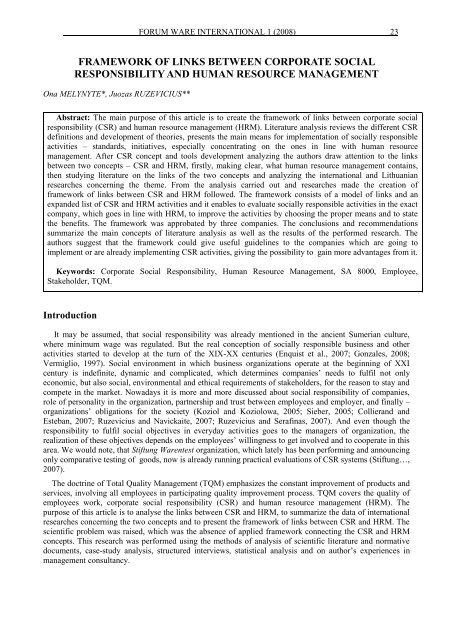

![[CV] Roma AdomaitienÄ - Vilniaus universitetas](https://img.yumpu.com/47453221/1/184x260/cv-roma-adomaitiena-vilniaus-universitetas.jpg?quality=85)
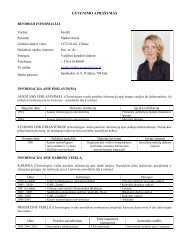
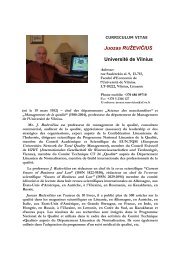


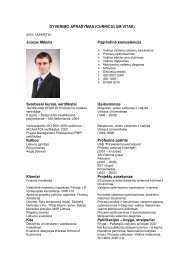
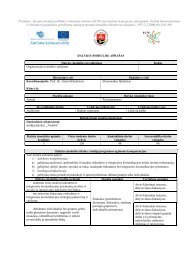
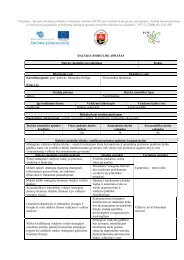
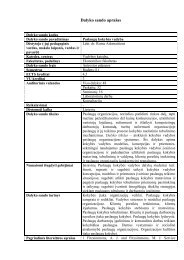

![[CV] Darius Klimas - Vilniaus universitetas](https://img.yumpu.com/32971109/1/184x260/cv-darius-klimas-vilniaus-universitetas.jpg?quality=85)
